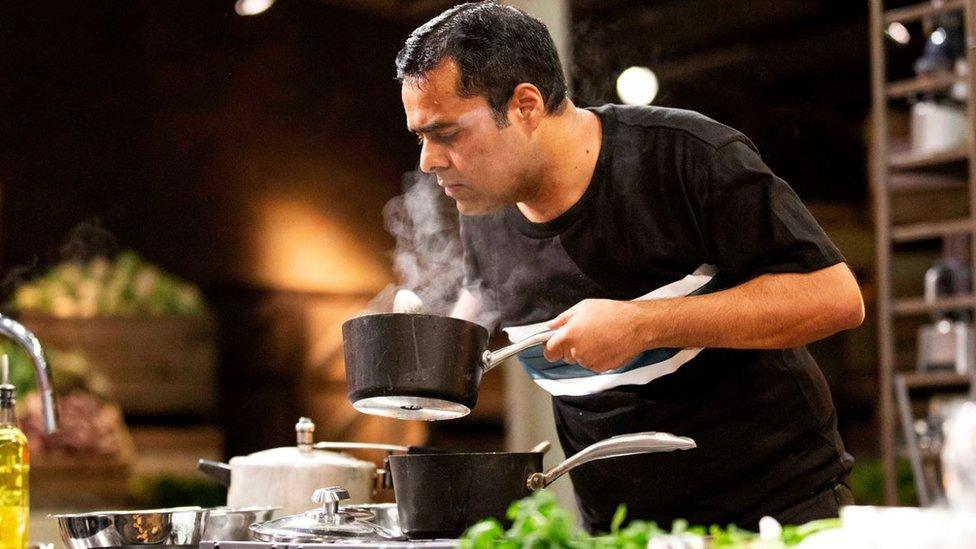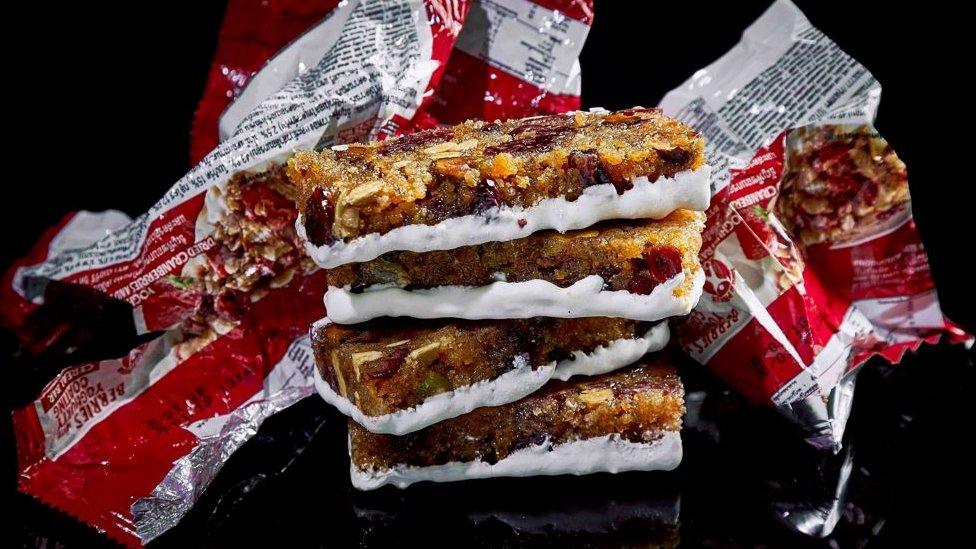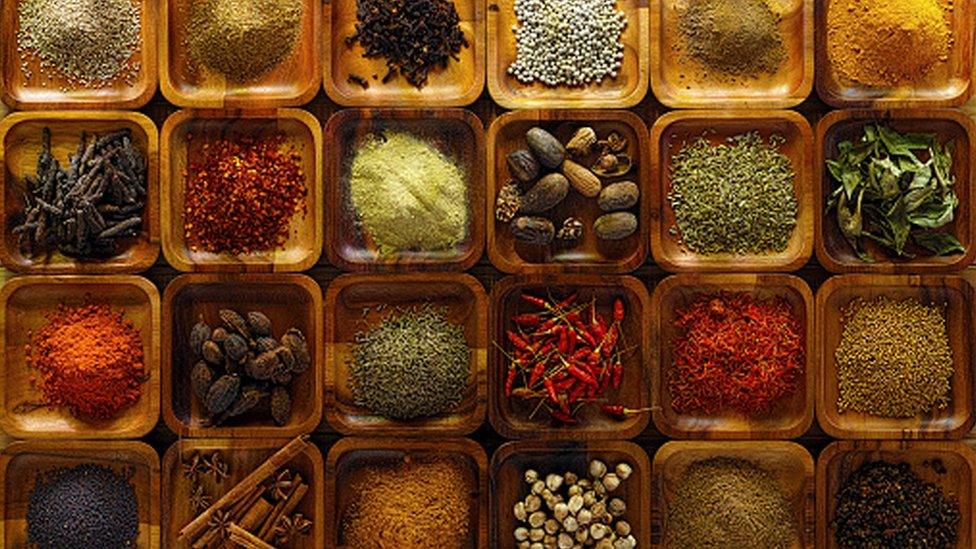MasterChef Australia: The cooks fighting Indian curry cliches
- Published

Indian food is hugely popular in the cooking show
As the 14th season of MasterChef Australia draws to a close, Indian food has once again taken centre stage in the popular cooking series.
The season's runner-up, Sarah Todd, presented amazing Indian dishes, including a pork vindaloo - a pungent and spicy dish from the coastal state of Goa.
MasterChef Australia is one of the most popular TV shows in India and the constant presence of cooks who are Indian-origin or share a connection to the country has only helped its popularity - it is a bigger hit in the country than the show's Indian version.
Over the years, contestants have wowed the judges with Indian dishes which are often traditional but sometimes come with a modern twist.
Rishi Desai, who finished fourth in Season 5 of the show in 2013, impressed the judges with his take on the palak paneer - a dish that has a thick spinach-and-cream gravy with heaps of cottage cheese.
Since then, every season has seen contestants dish out mouth-watering dishes that put India's bold regional flavours front and centre.

MasterChef Australia's popularity in India has grown over the years
Indian food doesn't need introduction in most parts of the world. But the show's Indian contestants have showcased the inexhaustible variety and range of flavours it offers.
"MasterChef Australia has taken the western world beyond "butter chicken and naan" to more and different Indian food and ingredient experiences," Sandeep Pandit, who contested in Season 11, says.
Mr Pandit has taken ideas from all over India to create recipes that, although are rooted in tradition, come with a unique modern twang - the most famous being his lobster masala.
"I always knew that even if I cook one Indian dish in every round that I have, I'll still never be able to showcase it all," he says.

Sandeep Pandit has taken ideas from all over India to create recipes
MasterChef is also known for spotlighting the exquisite ways food can look amazing on TV and has encouraged contestants to push the boundaries when it comes to presentation and ways to make dining a sophisticated experience.
That has raised a question: can Indian food compete in the fine-dining space with other cuisines like Italian and French? Or should it retain its unique nature, which is sometimes described as rustic?
"Does fine-dining mean stylish food served in small portions, with a hero ingredient and multiple elements complementing it, or the cuisine from the royal kitchens and tables from nobility across the world? In any case Indian food fits the scene," Mr Pandit says.

Mr Pandit's food is heavily inspired by traditional Indian recipes
Depinder Chhibber, a contestant in Season 13, remembers feeling utterly nervous the first time she served an Indian dish.
"That's because Indians underestimate our home food even though it's so powerful and the flavours are second to none," says the 30-year-old who wooed judges with dishes such as smoked lassi and kadhai paneer.
"But the judges loved my home-style Indian dishes."
Ms Chhibber says the limitations posed on Indian food are created by us: "There is so much you can do with Indian flavours".

There is no doubt that Indian cuisine is enjoying something of a renaissance globally.
There was a time when all dishes ended up being lumped together under one name - "curry" - which was then dismissed as "too spicy" or "too smelly", something that was devoid of any artistic possibilities.
But over the years, Indian chefs have dug deeper into old-age recipes and techniques and reinvented them into a unique fine-dining idiom.

Ms Chhibber made several Indian dishes like choley kulcha (chickpeas and flatbread)
Gaggan Anand, arguably one of India's most famous chefs, says the assumption that Indian food cannot be a contender for fine-dining is a fatuous misconception at best.
"We shouldn't even ask this - I have proved that Indian food can be fine dine," Mr Anand says with characteristic swagger.
Indeed, his eclectic style - imbibing modern influences and funky aesthetics but deeply anchored by the culture he grew up in Kolkata city - has turned his restaurant in Bangkok into the holy grail of fusion food and turned Mr Anand himself into a stuff of legend, "a food god", external.

Gaggan Anand, popularly called "the food god"...

...is known for inventive cooking
Food travellers from every corner of the globe descend upon his restaurant - which was ranked fourth on the World's 50 Best Restaurants list in 2019 - to experience dishes that defy conventional categorisation but are an aesthetic triumph. The most famous of these is called yogurt explosion, a ball of yogurt held together by a layer of gelatine that explodes in your mouth into a medley of flavours.
But Mr Anand acknowledges that just a few chefs like him cannot do justice to Indian food.
He blames the lack of creativity among those who are in positions of power in India's food industry, but is quick to add that chefs who try to be innovative also find it difficult to survive.
"Even if there are chefs coming who have an artistic bend of mind, it's that much harder for them to break through this whole capital system," Mr Anand says.

Mr Anand's food is an exciting blend of old and new cooking techniques
The entire culture, he adds, has to change. "It's not about presenting Indian food dressed as European but harnessing the rich heritage of our culture into putting out elegant plates of food," he says.
Mr Pandit feels that Indian chefs constantly seem to be battling the misconception that their food lacks nuance, when actually, the cuisine is "a universe in itself".
"We Indians love to stretch the boundaries of what's possible in food," he says. "The way we've incorporated chillies, tomatoes, cheese, chocolate, tea into our cooking, and the way our spices such as ginger, turmeric, cardamom and other intensifiers, have contributed to world cuisine, is a case study in itself."

India is home to a number of spices that are used in cooking
At the same time, Indians can make any culture's food uniquely their own, like they did with Indian-Chinese. Sold in both plush restaurants and roadside stalls, the cuisine employs Chinese techniques, but often has ingredients associated with Indian curries.
"This love to recreate something existing into something just as incredible, has been the true essence of Indian cuisine," Mr Dixit says.
But, as Ms Chhibber says, serving Indian food isn't always easy, especially in a competitive environment like MasterChef.
"There have been instances when I couldn't serve Indian food, for example, in the Italian team challenge where I had to make a light dessert to go with the pasta dishes we created for entrée and mains," she says.
Besides, sometimes the judges just want to see if the contestants can go beyond their comfort zone. "And for me that zone is Indian food," says Ms Chhibber.
Justin Narayan, the winner of Season 13, also remembers "feeling a little vulnerable" sometimes.

Justin Narayan won the MasterChef Season 13 in 2021
"Indian food is such a huge part of my life and my family's history so to be able to present it on the MasterChef stage is a huge honour," the cook of Fijian-Indian heritage says.
But the response he got was overwhelming. "More and more people want dishes that are real and authentic," he says, adding that MasterChef has given Indian food a distinguished platform by putting it alongside some of the world's best cuisines.
Mr Anand agrees, but he also thinks that one can't become a chef just from the show. "Even winners have to work hard to earn the chef's jacket," he says.
The real malaise, he says, is systemic in a country that is obsessed with churning out "doctors and engineers" and dismissing those who choose differently.
"True revolution in Indian cooking can only come when this mindset is changed."
Related topics
- Published14 March 2021

- Published22 October 2020
